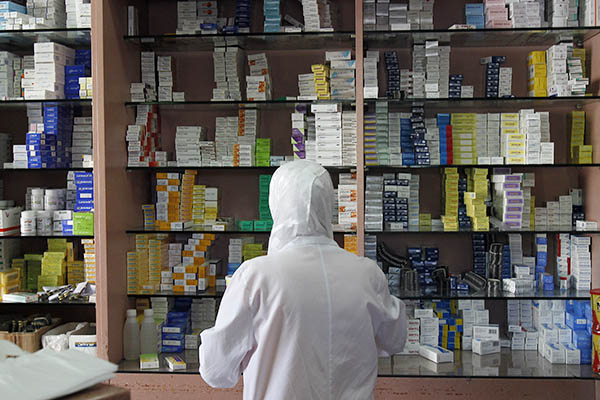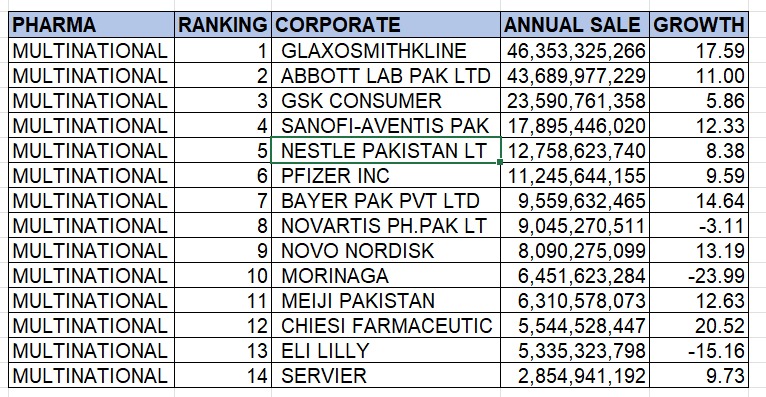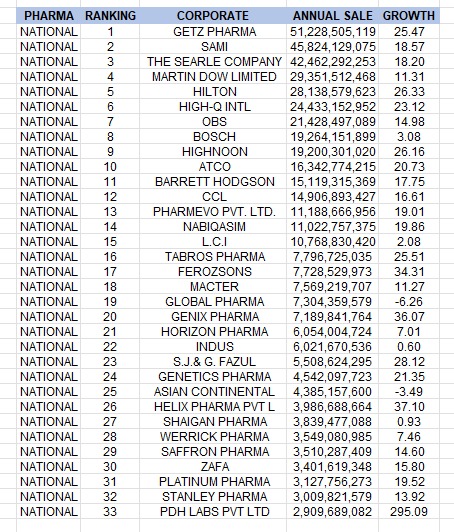
File photo. Anwar Amro—AFP
Amidst daily reports of a shortage of lifesaving drugs for Pakistani consumers despite several rounds of price hikes, the interim government has hinted at a crackdown against pharmaceutical companies to ascertain the “facts” over their stated cost of manufacturing and actual profits.
“The Drug Regulatory Authority of Pakistan (DRAP) has been directed to make an assessment and analysis report on the variations in cost between the import of raw material six months ago and currently,” Caretaker Health Minister Nadeem Jan told the Standard. “The situation demands they be brought under the tax net if they are evaders, and a proper mechanism is being formulated to counter their blackmailing tactics,” he added.
“Multinational companies have made billions of dollars in Pakistan and this hue and cry is because of some meager loss in profit,” he claimed, while acknowledging that the past year’s devaluation of the rupee against the dollar had raised costs for import materials. “The Ministry is trying to devise a mechanism to facilitate the pharma industry accordingly but pressure tactics won’t serve any purpose,” he added.
Stressing that the government’s priority was to safeguard public and national interest, he reiterated that most pharmaceutical companies had not posted any losses, as claimed by their representatives. Maintaining that the incumbent government would not bow to any pressure, he warned “the government knows how to establish its writ.”
Pushing back against the minister’s claims, however, the Pharma Bureau (PB)—a representative body of multinational pharmaceuticals in Pakistan—claimed three of the largest companies had posted losses for the first time since commencing operations in the country. Speaking with Standard, PB Executive Director Ayesha Tammy Haq said GSK, Abbott and Sanofi had all posted losses and criticized authorities’ failure to understand the severity of the crisis.
“Unfortunately, there is a complete lack of understanding of the issues faced by the pharmaceutical industry in Pakistan,” she said, referring to a recent meeting with the interim health minister and National Health Systems Resource Center Secretary Iftikhar Shallwani. “Both the minister and the secretary do not appear to understand the criticality of the situation and announced large and ambitious plans for the sector. These plans, even if implemented robustly, will take at least 4-5 years to mature,” she claimed. Noting that companies cannot be expected to sell a medicine for Rs. 10 if it costs Rs. 15 to manufacture, she maintained the companies had suffered heavy losses due to currency fluctuation and an unsustainable market.
In 2020, the government revoked a policy allowing companies to set their own prices, requiring any changes to be notified by DRAP and the Health Ministry. Earlier this year, the government announced a 14-20% hike in drug prices, stating it would not allow any further increase in the next fiscal year. Referring to this, Haq said the matter was pending in court. She further said hardship cases decided by the Drug Pricing Committee (DPC) of DRAP were still awaiting approval from the cabinet. “The DPC has evaluated the cost of each case and recommended a price adjustment after a robust scrutiny process which would still be lower than the price of the same drug in India,” she claimed.
Cost of devaluation
The Pakistan Pharmaceutical Manufacturer Association (PPMA) echoed the PB’s claims. Its representative Hamid Raza told Standard that the biggest driver of higher costs was the rupee’s devaluation against the dollar, raising production costs. “The Health Ministry is not ready to budge when it comes to an increase in the retail price, which results in shortage of medicines and their sale in the black market at higher costs,” he claimed, noting hoarders were profiting off companies shifting away from low-priced drugs.
Urging the government to rationalize the prices of medicines, he said a policy should be devised to link the rates of drugs to the value of the dollar and inflation. He also claimed many pharmaceutical companies were on the verge of bankruptcy due to the prevailing situation.
The health minister, however, maintained it was “logical” to ascertain the facts first. “Threats of winding up businesses from Pakistan are part of blackmailing tactics and they would never succeed it,” he said, warning that if there are attempts to create such a situation, the government possessed the resources to counter it.
Mass shortages
The biggest victim of the ongoing tussle over drug pricing is the average consumer, facing an unenviable choice between a rise in costs and a severe shortage. Pakistan Medical Association (PMA) Secretary General Dr. Qaiser Sajjad told Standard many prescribed medicines for patients were no longer available in the market. “Generic versions are being given to patients, as even if a patient is fortunate enough to secure the prescribed medicine, its cost is 300 times higher,” he said, claiming this was impacting procedures in government hospitals.
“We have never seen such shortages before in case of medicines or medical devices,” said pharmacist Waqas Hameed of Ghurki Hospital, Lahore. “Current situation is bit better in terms of availability as a few medicines, such as insulin, are being directly issued to registered patients to overcome shortages,” he said.
Addressing the shortages, the interim health minister said the government was considering an offer from Iran to provide various medicines to Pakistan at a cost 10 percent lower than the rates estimated by pharmaceutical companies. However, he added, this had yet to advance beyond the proposal stage. Referring to this, Haq warned it would destroy the local industry. “Why would you import medicines that can be manufactured locally? You would be destroying your own industry, losing tens of thousands of jobs, lost revenue to the exchequer, and unnecessarily using precious foreign exchange,” she said.

Dubious claims
But while the PB and PPMA maintain pharmaceutical companies are suffering heavy losses, the Pakistan Pharma Legal Forum (PPLF) has described such claims as “dubious,” citing publicly available data. The forum’s president, Dr. Noor Mehr, supported the health minister’s view that no company would wind up operations in the country.
“[Multinational companies] are in fact running in profits and 50 percent of their drugs are being manufactured by local pharmaceutical companies,” he claimed to the Standard. “For example, Novartis is a multinational pharma company whose drugs are prepared by local companies NovaMed and Indus Pharma,” he said, alleging several branded medicines cost significantly more than their generic versions but were not being supported by doctors as “powerful people” were resisting the move. A petition in the Lahore High Court is seeking redress, he added.
“For instance, a salt of amlodipine is used for to manufacture Norvasc medicine, which is prescribed for heart patients. Pfizer, a multinational company, sells it for Rs. 500, while the same medicine manufactured by Zafa, a local company, retails for Rs. 49,” he said, noting the gap was difficult to comprehend as both used the Dr. Reddy’s Laboratories in India for raw material.
Dr. Mehr further alleged that it was the pharmaceutical companies, and not the government, that were to blame for the “artificial shortage” of drugs in the country. Their failure to maintain an inventory of drugs in the market was a clear violation of the Drugs Act, 1976, he added.
The minister and PPLF’s claims are further supported by data provided by the International Medical Statistics (IMS), which collates profits and losses of major companies. Information about the last fiscal year states that of major multinationals, Glaxosmithkline posted a 17.59 percent profit; Chiesi Farmaceutic 20.52 percent; Sanofi-Aventis Pak 12.33 percent; Bayer Pak 14.64 percent; Novo Nordisk 13.19 percent; and Pfizer 9.59 percent. The companies to post a loss were Novartis with a 3.11 percent decline; Morinaga 23.99 percent; and Eli Lilly 15.16 percent. Of major local companies, meanwhile, Getz Pharma posted a profit of 25.47 percent; Hilton 26.33 percent; High-Q Intl 23.12 percent; Highnoon 26.16 percent; ATCO 20.73 percent; Ferozsons 34.31 percent; Genix Pharma 36.07 percent; Helix Pharma 37.10 percent; S.J & G. Fazul 28.12 percent; and PDH Labs 295.09 percent. Two companies—Global Pharma and Asian Continental—posted a loss.

The caretaker health minister, maintains that the best way to end Pakistan’s reliance on foreign supplies is to encourage localization. In this regard, he said, the government wanted to establish a Pharma Park that would ultimately increase production of medicines. To achieve this, he said, talks were underway with many countries for the transfer of technology. “We would also offer them land through public-private partnership to solve the problems of prices, supplies and damages on permanent basis,” he added. The ambitious plans could certainly prove a boon for citizens of Pakistan; but in the near-term, they are unlikely to find much relief as the gap between authorities and companies continues to widen.
